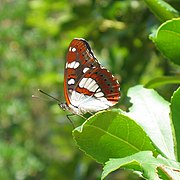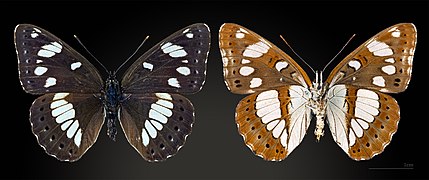Blue and black kingfisher
| Blue and black kingfisher | ||||||||||||
|---|---|---|---|---|---|---|---|---|---|---|---|---|

Blue-black kingfisher ( Limenitis reducta ) |
||||||||||||
| Systematics | ||||||||||||
|
||||||||||||
| Scientific name | ||||||||||||
| Limenitis reducta | ||||||||||||
| Staudinger , 1901 |
The blue-black kingfisher ( Limenitis reducta ) is a butterfly (day butterfly ) from the noble butterfly family (Nymphalidae).
features
The moths reach a wingspan of 45 to 50 millimeters. The basic color of the upper sides of the wings is black, but in contrast to the very similar small kingfisher ( Limenitis camilla ) you can see a blue shimmer. The wings also have a wide band of white spots which, when the wings are open, form a semicircle open to the front over the two pairs of wings. On the forewings, however, the bandage consists only of a few white spots, which are somewhat weaker than those of the similar species. A white spot is located a little apart between the basal and disk regions, near the wing leading edge, and along the outer edge of both wings runs a series of small blue spots. These two characteristics distinguish the species from the small kingfisher. The undersides of the wings have a rust-brown basic color. The basal field of the hind wings is extensively colored white, in the middle of the wings there is a wide, white band that encloses a narrow rust-brown stripe between itself and the basal field. This tapers to a point at the inner edge, as the two white areas touch here. Only a row of dark points runs parallel to the outer edge between the post-disc and sub-marginal region. The underside of the forewings bears three white spots along the front margin, the middle one being significantly larger than the other two. The body of the moth is white on the underside and dark on the upper side.
The caterpillars are about 27 millimeters long. They are colored light green to pale green on the upper side and red-brown to gray-violet on the underside. The color areas are separated by a white line on the side of the body. On the back there are numerous thorns arranged in pairs. They are brown in color and of different sizes.
Similar species
- Little Kingfisher ( Limenitis camilla )
- Black moth ( Neptis rivularis )
Synonyms
- Limenitis anonyma Lewis, 1872
Occurrence
The animals are found in southern and central Europe , Turkey , the Middle East to western Iran and the Caucasus . There is also an occurrence in Brittany and Normandy . They are absent north of southern Germany, the Balearic Islands , Crete and the Iberian Peninsula , except in their north. They occur from sea level up to an altitude of about 1,650 meters. The species is common from the northern Mediterranean region to the southern Alps , and is rare in Germany. The moths live on temperature-favored, sunny forest edges and clearings and in rocky and grassy places with shrub growth.
Way of life
Flight and caterpillar times
The moth flies in one generation in the north of the range from mid-June to early August. Two generations are formed in the Mediterranean, flying from mid-May to June and from mid-July to August.
Food of the caterpillars
The caterpillars feed on various hedge cherry species ( Lonicera ), such as from Red Honeysuckle ( Lonicera xylosteum ), Lonicera Caprifolium ( Lonicera caprifolium )., Lonicera Periclymenum ( Lonicera periclymenum ), Lonicera etrusca , tangled honeysuckle ( Lonicera implexa ), Alpine Honeysuckle ( Lonicera alpigena ) and Lonicera nummulariifolia .
development
The females lay their spherical and prickly eggs individually on the upper side of the leaves of the caterpillar forage plants. The caterpillars have almost the same way of life as that of the small kingfisher and are difficult to distinguish from one another, especially in the early stages. Those of the blue-black kingfisher always live in warm, sunny locations instead of shaded plants. The caterpillars first eat the tip of the leaf on both sides of the midrib and sit on it during feeding breaks. The rib is even lengthened by feces. At the end of summer, the young caterpillar builds a bag out of a leaf and silk, the so-called hibernarium , in which wintering takes place. The monochrome gray tumbler has one on the back and two other characteristic stubby projections on the head, but it lacks the metallic spots that the doll of the Little Kingfisher wears.
Hazard and protection
The blue-black kingfisher is on the red list in Germany and is listed as critically endangered (category 2).
swell
Individual evidence
- ↑ a b Heiko Bellmann : The new Kosmos butterfly guide. Butterflies, caterpillars and forage plants. Franckh-Kosmos, Stuttgart 2003, ISBN 3-440-09330-1 , p. 188.
- ↑ Limenitis reducta Staudinger 1901. Fauna Europaea, Version 1.3, April 19, 2007 , accessed on July 10, 2007 .
- ↑ a b c d Tom Tolman, Richard Lewington: Die Tagfalter Europäische und Nordwestafrikas , pp. 140f, Franckh-Kosmos Verlags-GmbH & Co, Stuttgart 1998, ISBN 3-440-07573-7
- ^ Günter Ebert: The butterflies of Baden Württemberg Volume 1, Tagfalter I. Ulmer Verlag Stuttgart 1993. ISBN 3-8001-3451-9
- ↑ Hans-Josef Weidemann: Tagfalter: watch, determine , p. 388f, Naturbuch-Verlag Augsburg 1995, ISBN 3-89440-115-X
- ↑ Federal Agency for Nature Conservation (Ed.): Red List of Endangered Animals in Germany. Landwirtschaftsverlag, Münster 1998, ISBN 978-3-89624-110-8
literature
- Josef Settele, Roland Steiner, Rolf Reinhardt, Reinart Feldmann: Butterflies. The butterflies of Germany. , Eugen Ulmer KG, 2005, ISBN 3-8001-4167-1

